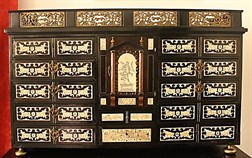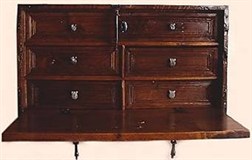To preserve reserved documents: papeleras and desks from the Baroque period
 The papeleras (furniture to store paper and documents) and the desks accounted for essential elements of the material culture of Spanish Baroque society. Now preserved in museums, palaces and noble’s mansions, they were used to hide and keep secret thoughts, private papers and official documents in order. Certainly, it is a piece of furniture that only the nobility could afford, not only because they had the financial resources to be able to buy these luxury items, but also because they were often the only ones to have received education and training that allowed them to put thoughts, ideas and projects to writing. The room where the desks and papeleras were positioned was in fact a place of work.
The papeleras (furniture to store paper and documents) and the desks accounted for essential elements of the material culture of Spanish Baroque society. Now preserved in museums, palaces and noble’s mansions, they were used to hide and keep secret thoughts, private papers and official documents in order. Certainly, it is a piece of furniture that only the nobility could afford, not only because they had the financial resources to be able to buy these luxury items, but also because they were often the only ones to have received education and training that allowed them to put thoughts, ideas and projects to writing. The room where the desks and papeleras were positioned was in fact a place of work.
Though home furnishings have been attested to since Roman times, it was, however, in the Early Modern period when the manufacturing of such items reached a high level of quality nurturing a thriving trade, both inside and outside the Iberian Peninsula, which explains their presence in any noble or royal house or palace.
 The papeleras were rectangular boxes, usually without a cover, divided at the front into several compartments or drawers and without a table which could be pulled out, which is why they did not have a surface on which to write, and served only to preserve documents (photo 1. Museo Nacional de Artes DecorativasThis museum contains the material culture of Spanish society, which enables us to interpret the ideas and values of its history. It is located in Madrid’s calle Montalbán. of Madrid). The desks had a shape which was very similar to that of papeleras, but over time they ended up look more like tables, which made writing more comfortable and had less drawers or shelves (photo 2. Museo National de Artes Decorativas of Madrid). Sometimes they were equipped with drawers which could be locked, the so-called secretos, to which only the owner could access. The wood used in Baroque Spain for this kind of furniture was pine or walnut. On the sides there were almost always handles to easily transport such objects, which on many occasions followed the owners in their transfers, as in the case of the viceroy. The shapes, the type of decorations and preferences – according to the period – the use of a quality of wood instead of another permit precise dating of this furniture. In the seventeenth century there was a marked change in them, with additional differences from region to region. For example, some specimens showed inlays produced in the “German” style, or mixed vegetable motifs with typically oriental materials and western forms. In Spain the use of decorative turtle shells mixed with bone plaques also spread, which was characteristic of Italian production, above all Neapolitan, of the second half of the seventeenth century.
The papeleras were rectangular boxes, usually without a cover, divided at the front into several compartments or drawers and without a table which could be pulled out, which is why they did not have a surface on which to write, and served only to preserve documents (photo 1. Museo Nacional de Artes DecorativasThis museum contains the material culture of Spanish society, which enables us to interpret the ideas and values of its history. It is located in Madrid’s calle Montalbán. of Madrid). The desks had a shape which was very similar to that of papeleras, but over time they ended up look more like tables, which made writing more comfortable and had less drawers or shelves (photo 2. Museo National de Artes Decorativas of Madrid). Sometimes they were equipped with drawers which could be locked, the so-called secretos, to which only the owner could access. The wood used in Baroque Spain for this kind of furniture was pine or walnut. On the sides there were almost always handles to easily transport such objects, which on many occasions followed the owners in their transfers, as in the case of the viceroy. The shapes, the type of decorations and preferences – according to the period – the use of a quality of wood instead of another permit precise dating of this furniture. In the seventeenth century there was a marked change in them, with additional differences from region to region. For example, some specimens showed inlays produced in the “German” style, or mixed vegetable motifs with typically oriental materials and western forms. In Spain the use of decorative turtle shells mixed with bone plaques also spread, which was characteristic of Italian production, above all Neapolitan, of the second half of the seventeenth century.
